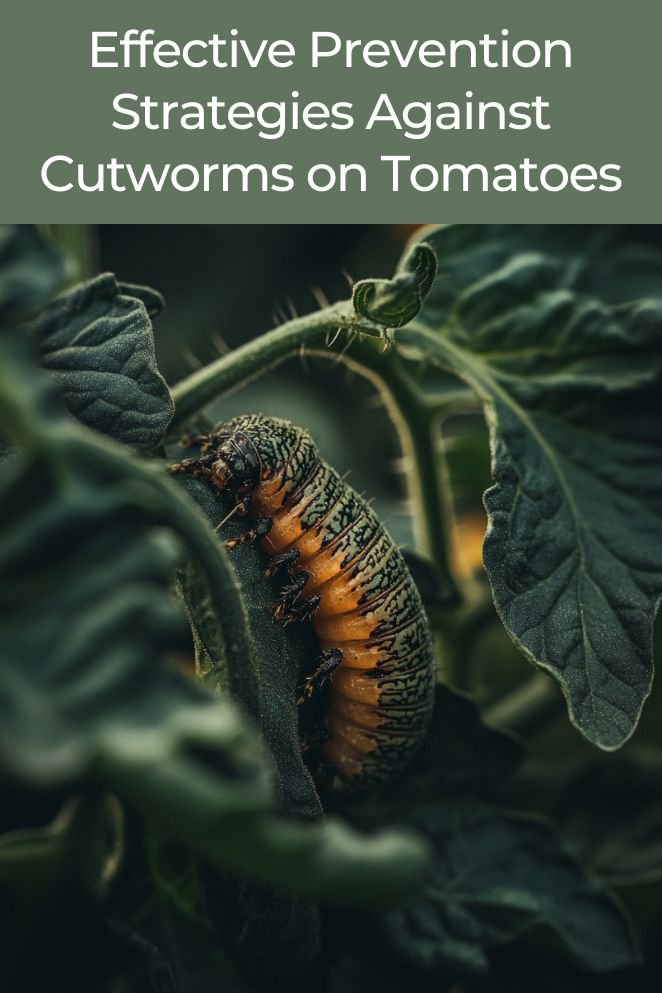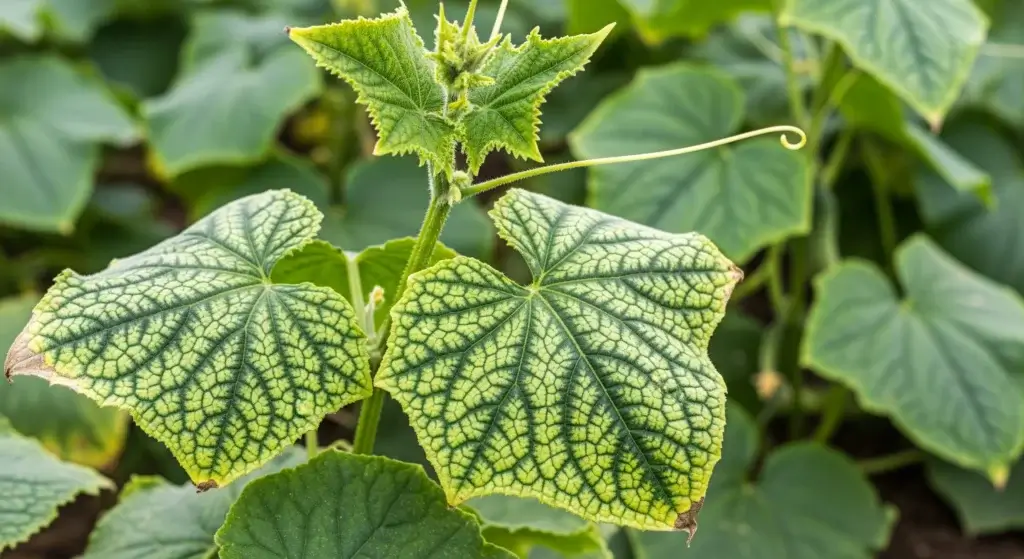
Cutworms are common garden pests that target young plants, particularly during the early stages of their growth.
These pests, which are the larvae of certain moth species, can quickly destroy your tomato plants by cutting through their stems at the soil line.
This makes managing cutworms essential for ensuring a successful tomato harvest.
Knowing what attracts cutworms, the signs of their presence, and effective prevention and control methods will help you keep your garden healthy and productive.
Factors Attracting Cutworms to Gardens
Cutworms are generally attracted to gardens with plenty of organic material and moist soil, both of which provide the conditions they need to thrive.
Here are a few factors that can make your garden appealing to these pests:
- Dense vegetation: Gardens with dense ground cover and heavy mulching can provide excellent shelter for cutworms.
- Moist soil: Cutworms prefer moist environments where they can hide during the day and emerge at night.
- Debris: Gardens with plant debris or excess organic matter may attract cutworms by providing additional cover.
Understanding these factors can help you adjust your garden environment to make it less attractive to cutworms.
Damage Cutworms Cause to Tomato Plants
Cutworms are named for their destructive habit of cutting down young plants at the base.
They typically feed at night, slicing through plant stems at the soil line, which leads to wilting or death of the plant.
According to research from the Journal of Economic Entomology, cutworm damage can result in significant crop losses if left unmanaged.
In tomato plants, this damage is particularly frustrating since young tomato seedlings are highly vulnerable.
- Read also: Growing Healthy: A Guide to Natural Pesticides for Tomatoes
- Read also: Effective Strategies for Getting Rid of Tomato Hornworms

Common Signs of Cutworm Damage
- Seedling collapse: If your young plants suddenly droop and wilt, it might be due to cutworms.
- Stem cuts: Cutworms leave clean cuts right at the soil line of the plant’s stem. If you notice these kinds of cuts, it’s a clear sign of cutworm activity.
- Holes in leaves: Some types of cutworms also chew on leaves, leaving holes. If you see these, along with stem damage, it’s likely you’re dealing with cutworms.
Identifying Cutworms
Cutworms are typically found hiding in the soil during the day and are more active at night.
Here’s what to look for:
- Appearance: Cutworms are smooth, fat caterpillars, usually gray, brown, or black, and can grow up to 2 inches long.
- Behavior: They tend to curl up into a “C” shape when disturbed.
- Location: Check near the base of your plants, as cutworms usually hide just below the soil surface during the day.
Spotting cutworms early can help you act before they cause severe damage.
Prevention Strategies
Preventing cutworms from infesting your garden is key to protecting your tomato plants.
Here are some strategies:
Cultural practices
Using good gardening habits, or cultural practices, can help you manage cutworms and protect your plants.
Here are three helpful strategies:
Crop rotation
Crop rotation means planting different crops in different spots each season.
This practice makes it harder for pests like cutworms to establish themselves.
For example, if you grow tomatoes in one area this year, plant them somewhere else the next.
By moving your crops around, you interrupt the cutworms’ lifecycle since they won’t find their preferred plants in the same spot season after season.
Clean garden hygiene
Keeping your garden clean can go a long way in preventing cutworm issues.
Cutworms love hiding in plant debris, fallen leaves, and weeds.
By regularly removing this garden clutter, you take away potential hiding spots, making it less inviting for cutworms.
This simple habit not only reduces pest problems but also helps your plants stay healthier overall.
Tilling the soil
Tilling the soil in early spring can help disrupt the cutworm lifecycle.
By turning over the soil, you expose cutworm larvae to the surface, where they’re more likely to be eaten by birds or other natural predators.
Tilling also disrupts their environment, making it harder for them to develop.
It’s a simple but effective way to reduce cutworm populations before the planting season begins.

Physical barriers
Collars around young plants
One of the best ways to protect young tomato plants from cutworms is by placing collars around them.
You can make these collars from cardboard, plastic, or metal.
Position the collar so it extends about an inch into the soil and rises a few inches above the ground.
This creates a physical barrier that cutworms can’t crawl over, keeping them from reaching your plant stems.
Row covers
Using row covers or fine mesh over your plants can prevent cutworm moths from laying eggs on or around them.
These covers act as a shield, especially useful early in the season when pests are most active.
Row covers allow light and water through but keep the moths out, reducing the chance of cutworm larvae appearing.
Mulch carefully
While mulch is great for maintaining soil moisture and controlling weeds, too much mulch can create ideal hiding spots for cutworms.
Use mulch sparingly around vulnerable plants, so there’s less cover for cutworms to hide in during the day.
A thin layer is fine but try to avoid deep or dense mulching where cutworms might find shelter.
Natural predators
Encouraging natural predators is an eco-friendly way to control cutworms.
Beneficial insects such as beetles, parasitic wasps, and birds can help keep cutworm populations in check.
You can attract these predators by planting flowers like marigolds, daisies, and cosmos, which attract insects that prey on cutworms.

Control Methods
If cutworms have already infested your garden, here are some control methods to consider:
Handpicking
One of the simplest ways to manage cutworms is to inspect your garden at night and handpick them from the soil.
Look around the base of your tomato plants, where cutworms are likely to hide.
This approach is time-intensive but effective if you have a small garden.
Traps
Traps can also help control cutworm populations.
You can create simple traps by placing cardboard or wooden boards around your garden at night.
The cutworms will hide under them during the day, making it easier to collect and remove them.
Biological control
Biological control involves using natural pathogens to target cutworms.
Beneficial nematodes, which are microscopic worms, can be applied to your soil to kill cutworm larvae.
According to research published in Biocontrol Science and Technology, nematodes are effective in reducing cutworm populations without harming plants.
Another option is Bacillus thuringiensis (Bt), a bacterium that targets caterpillars like cutworms.
When ingested, Bt disrupts the digestive system of the cutworms, leading to death.
Bt is considered safe for plants, pets, and people, making it a popular choice for organic gardeners.
Chemical control
While chemical control should be a last resort, insecticides can help manage severe infestations.
Look for insecticides labeled for cutworms and follow the application instructions carefully.
It’s essential to apply these treatments in the evening, as cutworms are more active at night.
However, keep in mind that insecticides may also affect beneficial insects, so use them sparingly.

- Read also: Beat the Blight: Common Fungal Diseases of Tomatoes
- Read also: A Comprehensive Guide: Controlling Bacterial Spot on Tomatoes
Final Thoughts
Cutworms can pose a significant threat to your tomato plants, but by taking proactive measures, you can keep them at bay.
A combination of cultural practices, physical barriers, and biological control can effectively manage cutworm populations while preserving a healthy garden ecosystem.
Remember, a balanced approach is key—encourage natural predators, maintain good garden hygiene, and consider handpicking and traps before resorting to chemicals.



